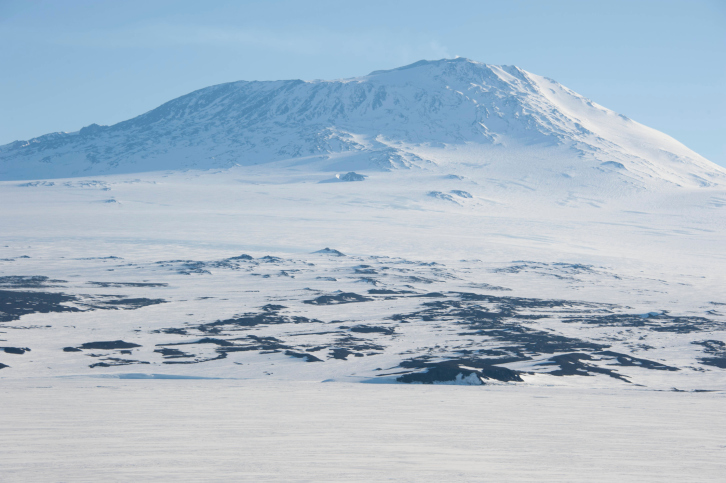
Mount Erebus, Antarctica. NASA satellite measurements show the polar ice caps have not retreated at all.
Updated NASA Data: Global Warming Not Causing Any Polar Ice Retreat
by James Taylor
May 19, 2015
[dropcap]U[/dropcap]pdated data from NASA satellite instruments reveal the Earth’s polar ice caps have not receded at all since the satellite instruments began measuring the ice caps in 1979. Since the end of 2012, moreover, total polar ice extent has largely remained above the post-1979 average. The updated data contradict one of the most frequently asserted global warming claims – that global warming is causing the polar ice caps to recede.
The timing of the 1979 NASA satellite instrument launch could not have been better for global warming alarmists. The late 1970s marked the end of a 30-year cooling trend. As a result, the polar ice caps were quite likely more extensive than they had been since at least the 1920s. Nevertheless, this abnormally extensive 1979 polar ice extent would appear to be the “normal” baseline when comparing post-1979 polar ice extent.
Updated NASA satellite data show the polar ice caps remained at approximately their 1979 extent until the middle of the last decade. Beginning in 2005, however, polar ice modestly receded for several years. By 2012, polar sea ice had receded by approximately 10 percent from 1979 measurements. (Total polar ice area – factoring in both sea and land ice – had receded by much less than 10 percent, but alarmists focused on the sea ice loss as “proof” of a global warming crisis.)
A 10-percent decline in polar sea ice is not very remarkable, especially considering the 1979 baseline was abnormally high anyway. Regardless, global warming activists and a compliant news media frequently and vociferously claimed the modest polar ice cap retreat was a sign of impending catastrophe. Al Gore even predicted the Arctic ice cap could completely disappear by 2014.
In late 2012, however, polar ice dramatically rebounded and quickly surpassed the post-1979 average. Ever since, the polar ice caps have been at a greater average extent than the post-1979 mean.
Now, in May 2015, the updated NASA data show polar sea ice is approximately 5 percent above the post-1979 average.
During the modest decline in 2005 through 2012, the media presented a daily barrage of melting ice cap stories. Since the ice caps rebounded – and then some – how have the media reported the issue?
This article was originally published by Forbes. Read the original article.

RELATED | Climate change credibility tool shows what news you can trust
by Olivia Solon
January 13, 2016

(Image: Jeffrey Blackler / Alamy)
“GLOBAL warming is the greatest scam in history.” Denialist headlines like this one litter the internet, confusing the public and frustrating climate scientists.
That frustration prompted Emmanuel Vincent at the University of California, Merced, to create Climate Feedback, a tool that lets climate scientists review journalists’ reports on the subject and give each story a credibility score.
The system uses a web annotation browser extension called Hypothesis to enable an invited group of climate scientists to comment on words, sentences or data points within media stories. Anyone who installs the plug-in can see the additional layer of commentary.
“Highlight misinformation, and it sends a visual cue to the reader to be cognitively on guard”
For example, one Forbes article headlined “Updated NASA Data: Global Warming Not Causing Any Polar Ice Retreat” has 33 comments from nine scientists who have given it the lowest possible credibility score. The piece, one of the site’s most popular climate stories of 2015, “contains many invalid and unjustified claims”, says Jan Lenaerts, who studies polar climate and ice sheets at Utrecht University in the Netherlands. It’s not the first attempt to fact-check the internet. Other tools include email fact-checker LazyTruth and web page annotation tool Truth Goggles, but all of them reach just a self-selecting few, says Matt Stempeck, who created LazyTruth. Getting Google to take these annotations into account when ranking search results would let initiatives like Climate Feedback make more impact, he says. Google is testing a model that assesses the trustworthiness of web content.
John Cook of the Global Change Institute at the University of Queensland, Australia, says that Climate Feedback could be powerful from a psychological point of view. “One of the reasons why misinformation is so problematic is because once a myth takes hold, it is fiendishly difficult to dislodge,” he says. “By highlighting misinformation, you’re sending a visual cue to the reader to be cognitively on guard.”
Vincent plans to launch a Kickstarter campaign next month to recruit more climate scientists and to develop a system for scoring the overall credibility of a publication’s climate coverage to help guide readers. The same approach could be applied to other fields such as GMOs, he says.
This article was originally published by New Scientist. Read the original article.